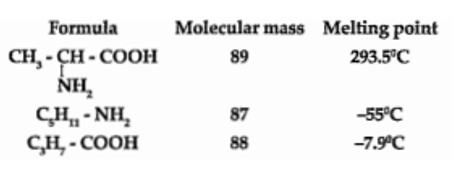Compare the molecular masses of the following compounds and explain the observed melting points
 Solution in Marathi
Solution in Marathi
Step by step video & image solution for Compare the molecular masses of the following compounds and explain the observed melting points by Chemistry experts to help you in doubts & scoring excellent marks in Class 12 exams.
Updated on:21/07/2023Topper's Solved these Questions
Similar Questions
CH2OH−CO−(CHOH)4−CH2OH is an example of
View SolutionThe hybridization of nitrogen in primary amine is……..
View SolutionIn the reaction 2N2O5(g)→4NO2(g)+O2 at a certain time. The rate of formation of NO2 is 0.08Ms−1. Find the rate of consumption of N2O5, rate of formation of O2 and the rate of the reaction.
View SolutionComparatively low melting point and insolubility in water of AICI3 is explained by ______rule .
View SolutionExplain why alcohols and ethers of comparable molecular mass have different boiling points?
View SolutionExplain why the ethers and alcohols of comparable molecular mass have different boiling points ?
View SolutionExplain why alcohols and ethers of comparable molecular mass have different boiling points?
View SolutionExplain the variation of melting points and boiling points with increase in molecular mass of alkanes.
View SolutionExplain as there is increase in molecular weight of alkane there is increase in boiling point and melting point.
View SolutionGive the following information of carbon dioxide: Molecular formuls, Molecular mass, Melting point, Percentage occurrence in air.
View SolutionExplain Boiling point of amines as compared to corresponding alkanes alcohols and corboxylic acids of compareble molecular mass.
View SolutionExplain the following:
Covalent compounds usually have low melting and boiling points.
View SolutionExplain the following: lonic compounds have high melting point and boiling point while covalent compounds have low melting and boiling points.
View Solutionव्याख्या कीजिए कि निम्नलिखित यौगिकों में से किसका गलनांक उच्चतर होगा :
LiCl अथवा KCl
View SolutionExplain why the boiling points of aldehyde and ketone are higher than hydrocarbons and ethers of comparable molecular masses?
View Solution